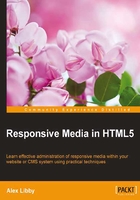
Conventions
In this book, you will find a number of styles of text that distinguish between different kinds of information. Here are some examples of these styles and an explanation of their meaning.
Code words in text, database table names, folder names, filenames, file extensions, pathnames, dummy URLs, user input, and Twitter handles are shown as follows: "Catering for HD/Retina images and using the <picture> tags."
A block of code is set as follows:
img { max-width: 100%; height: auto; float: left; padding: 10px; }
#description { box-sizing: border-box; }
#peytoe { ... padding: 0px 10px 10px; width: 66%; }
When we wish to draw your attention to a particular part of a code block, the relevant lines or items are set in bold:
<title>Demo - Setting a viewport using CSS</title>
<meta name="viewport" content="width=360">
<link href="css/viewport-css.css" rel="stylesheet">
Any command-line input or output is written as follows:
npm install grunt-cli grunt-contrib-watch grunt-autoprefixer
New terms and important words are shown in bold. Words that you see on the screen, in menus or dialog boxes for example, appear in the text likes this: "Click on the cog, then select Share and embed map."
Note
Warnings or important notes appear in a box like this.
Tip
Tips and tricks appear like this.